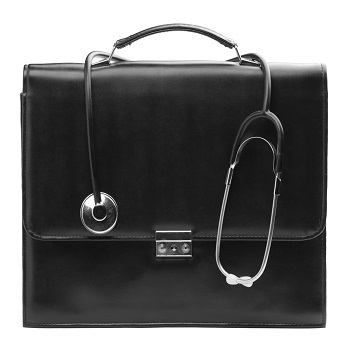Spinal epidural abscess
A patient presented with acute-on-chronic lumbosacral back pain and new-onset urinary incontinence.
The patient
A 46-year-old man with lumbar radiculopathy after L4 laminectomy without hardware, chronic pain syndrome, class III obesity, major depression, and generalized anxiety disorder presented with acute-on-chronic lumbosacral back pain with new-onset urinary incontinence. He did not report any recent injury, lower-extremity weakness, fall, gait disturbance, or surgery. Upon arrival, he was afebrile and hemodynamically stable. Physical exam was notable for lumbosacral paraspinal muscle tenderness and positive left-sided supine straight leg raise test. Motor and sensory examination was normal in L2-S1 regions, as was reflex testing.

Collateral workup was notable for neutrophilic leukocytosis with a white blood cell count of 12.1 × 109/L (reference range, 4.5 to 11.0 ×109/L) and elevated erythrocyte sedimentation rate (ESR) of 80 mm/h (reference range, 1 to 13 mm/h), mild transaminitis with cholestatic pattern, and severe hypokalemia of 2.9 mEq/L (reference range, 3.6 to 5.2 mEq/L). Urinalysis was bland without evidence of infection. Transthoracic echocardiogram showed normal biventricular function without regional wall-motion abnormalities or evidence of valvulopathy. Abdominal ultrasound showed no evidence of cholecystitis, biliary ductal dilatation, or cirrhotic changes. A CT of the lumbar spine demonstrated moderate canal narrowing at L1-L4 with a 3-mm calcified density within the spinal canal at the L4 level. MRI could not be obtained due to the patient's body habitus and unavailability of an open MRI. Neurosurgery was consulted and recommended nonemergent transfer to a tertiary medical center for further evaluation, including open MRI. The patient was given potassium supplementation, pain control, and other supportive treatment. Empiric antimicrobials were held given lack of a clear infectious source. He was transferred the following morning.
Gadolinium-enhanced MRI revealed an extensive heterogeneous epidural fluid collection with homogenous T2 signal and rim of enhancement centered at L3-L4 extending cephalad to L1 and caudally to L5, with relatively severe central canal narrowing from L1-2 through L4-5 with component of osteomyelitis involving the L3 and L4 spinous processes. Blood cultures were positive for methicillin-sensitive Staphylococcus aureus (MSSA). He was started on broad-spectrum antimicrobials and admitted to the ICU. An emergent decompressive laminectomy with debridement of infected tissues was performed. He was eventually discharged on six weeks of IV cefazolin (congruent with microbial cultures and susceptibilities) to follow up with infectious diseases and neurosurgery.
The diagnosis
The diagnosis is spinal epidural abscess (SEA). Spinal epidural abscess is an uncommon but potentially devastating condition that can be challenging to diagnose. Because SEA often presents with nonspecific findings such as back pain, fever, leukocytosis, and/or elevated inflammatory markers, it is commonly misdiagnosed on presentation, particularly in patients without focal neurologic signs, with delayed diagnosis seen in up to 75% of cases. Thus, diagnosis of SEA requires an appropriate level of suspicion and understanding of the diagnostic evaluation to minimize its morbidity.
The three most common symptoms (or “classic triad”) of SEA are back pain (~75%), fever (~50%), and neurologic deficit (approximately one-third of cases). Although this classic triad is highly specific for SEA, all three are only evident in a minority (7.9%) of cases. Clinically, the progression of SEA is classified into four stages: back pain (stage I), nerve root symptoms (stage II), muscle weakness and paresthesia (stage III), and complete paralysis (stage IV). The severity of neurological deficit can evolve to complete paralysis within just a few hours or days.
SEA is most commonly seen in patients older than age 60 years and those with multiple medical comorbidities. Known predisposing factors that increase the likelihood of SEA include diabetes, IV drug use, spinal trauma, end-stage renal disease, immunosuppressant therapy, recent invasive spine procedures, and concurrent infection of the skin or urinary tract. Diabetes is the most important and consistent risk factor, associated with 15% to 33% of SEA cases.
Suspicion for SEA is often founded on clinical findings and supported by lab and imaging studies, but it can only be confirmed by surgical drainage. The thoracic spine is the site most commonly involved, followed by the lumbar spine. Leukocytosis is seen in a majority of cases and inflammatory markers are almost universally elevated; however, neither the presence nor degree of these factors is specific for SEA. Bacteremia (either causing or arising from SEA) is detected in about 60% of patients. Bacteria gain access to the epidural space via contiguous spread (approximately one-third of cases) or hematogenous dissemination (around 50% of cases); the source of infection is unidentified in the remainder of cases. MSSA is the most common causative pathogen of SEA, accounting for about two-thirds of cases, followed by other gram-positives and Escherichia coli. Bacteremia is more commonly seen in those infected with S. aureus than other organisms.
Gadolinium-enhanced MRI of the spinal column is the preferred imaging modality and should be obtained emergently to delineate the location and neural compressive effects of the abscess. Decompressive laminectomy and debridement of infected tissues should be done as soon as possible as prognosis is highly dependent on intervening before neurologic deficits develop. The most important predictor of neurologic outcome is preoperative neurologic status. Conservative treatment with antimicrobial therapy alone is justifiable only for specific indications. Medical treatment may be a viable alternative for patients with back pain alone, stable neurologic symptoms for 72 hours without sepsis, and an identified microorganism. Close follow-up is essential as deterioration of neurologic function and/or development of systemic sepsis should prompt surgical decompression.
Pearls
- Spinal epidural abscess has a classic triad of symptoms—fever, spinal pain, and acute neurological deficit—but all three are present in only a minority of patients.
- Definitive treatment of SEA with associated neurological deficits is decompressive laminectomy combined with antimicrobial therapy; conservative treatment with antimicrobial therapy alone is justifiable only for specific indications.



